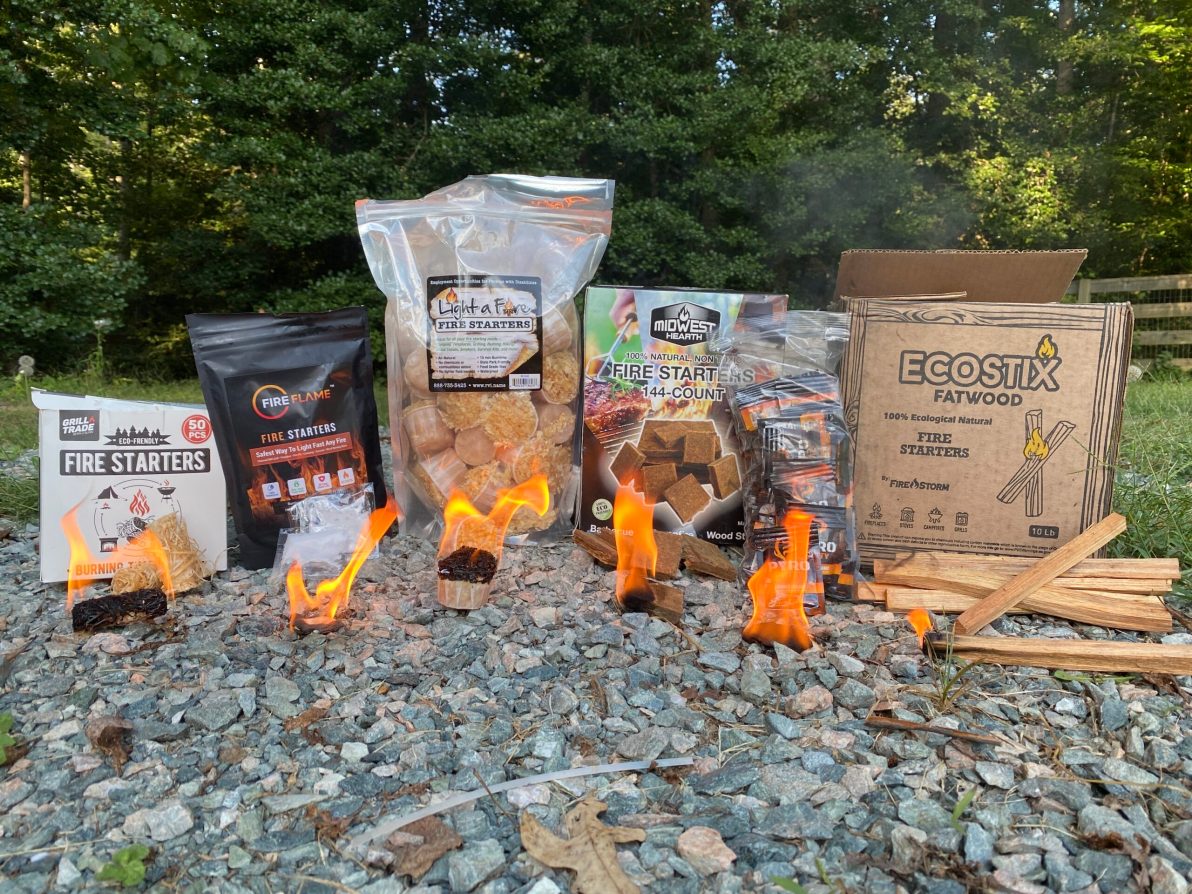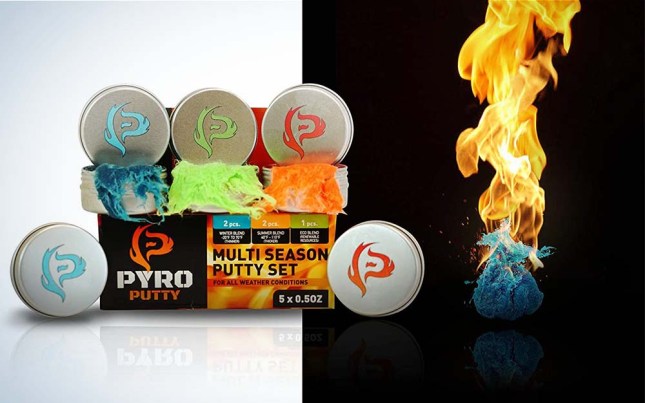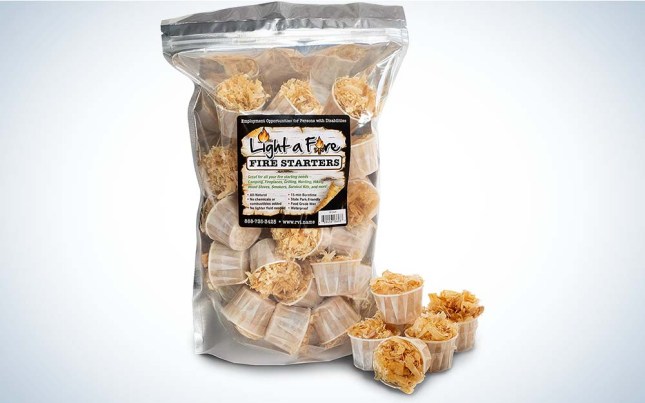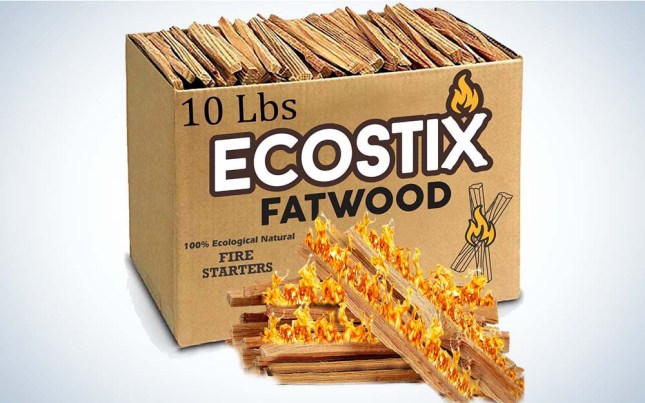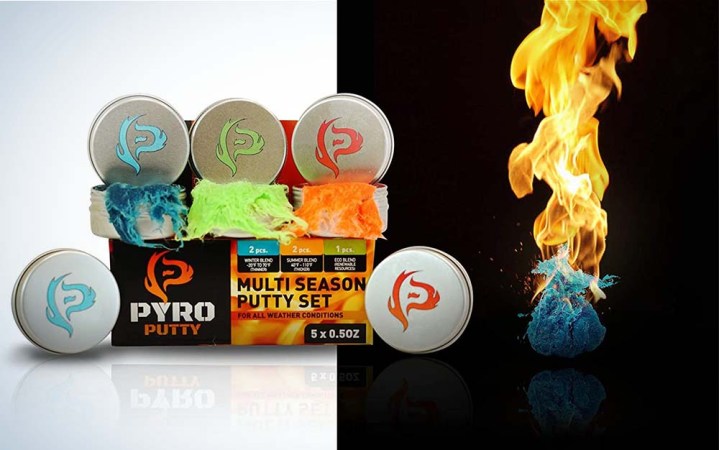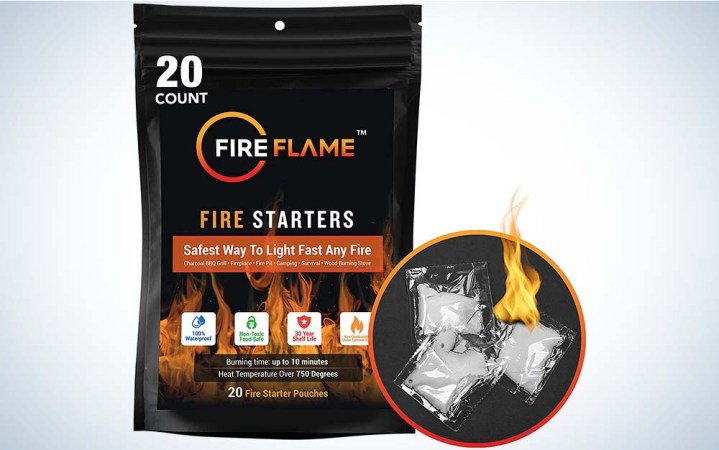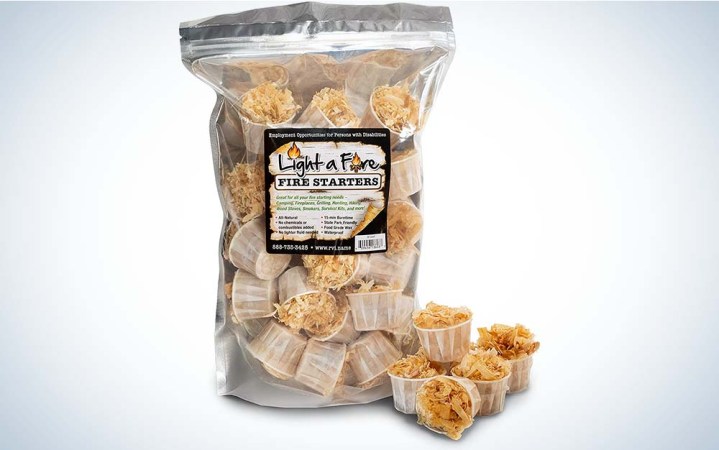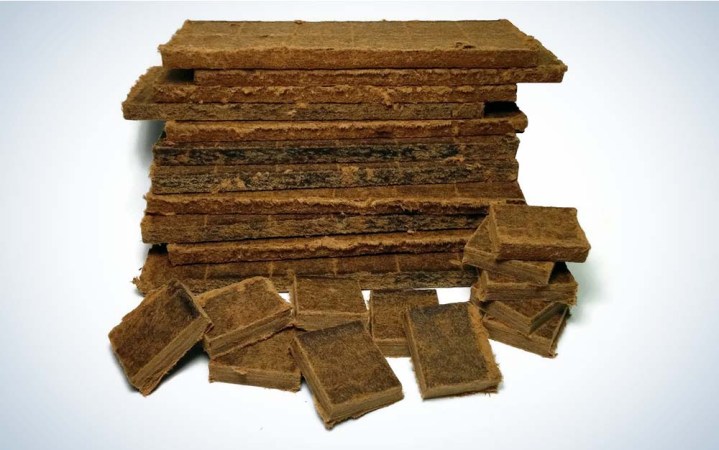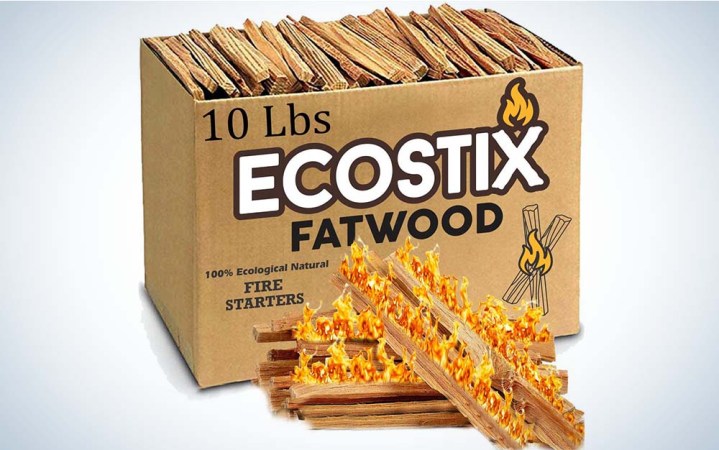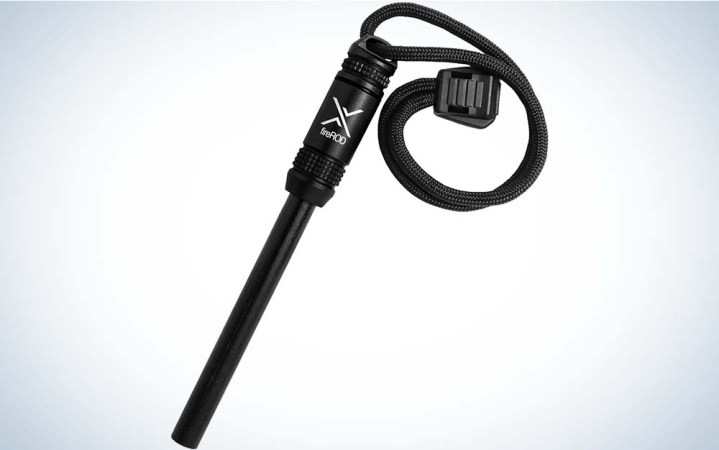We may earn revenue from the products available on this page and participate in affiliate programs. Learn More ›
I love building fires, but I don’t always want to go through the trouble of making a feather stick or collecting birch bark. That’s where fire starters come in. They’re like hitting the easy button for fire starting, but they’re not all created equal. The best fire starters will light easily and stay lit to ignite your kindling.
To help you find the best fire starter, I evaluated the top brands on the market in a series of tests. I evaluated each fire starter for burn time, waterproofness, wind resistance, and ease of lighting. The below fire starters are the best of the best for different applications. The burn time and waterproofness rating in the key features section of each review are based on my test, not on advertised time or rating. Here are my top picks:
- Best Fire Starter: Pyro Putty
- Best for Survival: FireFlame
- Best for Camping: Superior Trading Co Light a Fire
- Best for the Fireplace: Midwest Hearth
- Best Natural Fire Starter: Eco-Stix Fatwood
- Best Ferro Rod: Exotac fireROD
- Easy DIY: Dryer lint, egg carton, and candle wax
How I Chose the Best Fire Starters
Whether you’re starting a fire in your fireplace or on a remote backpacking trip, you need a fire starter to easily light and start your fire. To find the best fire starters, I tested them under the same set of conditions to gauge their performance. I wanted to find out how they performed in the following conditions:
- Burn time (How long does it burn for?)
- Wind performance (Will high wind extinguish the flame?)
- Waterproofness (Will it light when wet?)
- Ease of ignition (Is it easy to light?)
To test the burn time, I lit the fire starter and timed how long it took to burn out. This test is helpful because a longer burn time means there’s a better chance it will ignite your fire’s fuel. This was also a good baseline test to see the size of the flame and how well each burned. How each performed in the burn time test is noted in the key features section.
For the wind performance test, I lit the fire starter and then positioned a leaf blower three yards away on idle. The steady stream of air simulated high winds.
For the waterproofness test, I submerged each fire starter in a bucket of water for 7 minutes. For the individually wrapped fire starters I opened the package before submerging them. Then I attempted to light each fire starter.
The last thing you want is a fire starter that’s difficult to light. To test how easy the first starters were to ignite, I used a bic lighter and timed how long from the moment the flame touched the fire starter to how long it ignited.
Best Fire Starters: Reviews & Recommendations
Best Fire Starter: Pyro Putty
Key Features
- Burn Time: 8 minutes
- Stays lit in high wind
- Waterproof
Pros
- Easy to carry in a pack or survival kit
- Easy to light
- Long burn time
- Weatherproof
Cons
- Slow to light if wet
- Not all-natural
The Phone Skope Pyro Putty is a well-thought-out fire starter with more uses than just starting fires. If your tent springs a leak, you can rub Pyro Putty on the area to waterproof it. It’s available in different formulas that are optimized for different times of year. Pyro Putty makes a cold-weather and warm-weather putty, as well as an all-natural and ultralight version. I tested the warm weather Pyro Putty on a sunny 80 degree day.
The Pyro Putty I tested came in individually wrapped packages with a small amount of putty in each package. For the first test, I removed the putty from the package, lit it with a lighter, and started my stopwatch. It produced a good size flame for five minutes and then started to die down. At 8 minutes the flame went out. That’s a respectable burn time for just .1 ounce of material. It was also extremely easy to light, taking less than a second to catch fire.
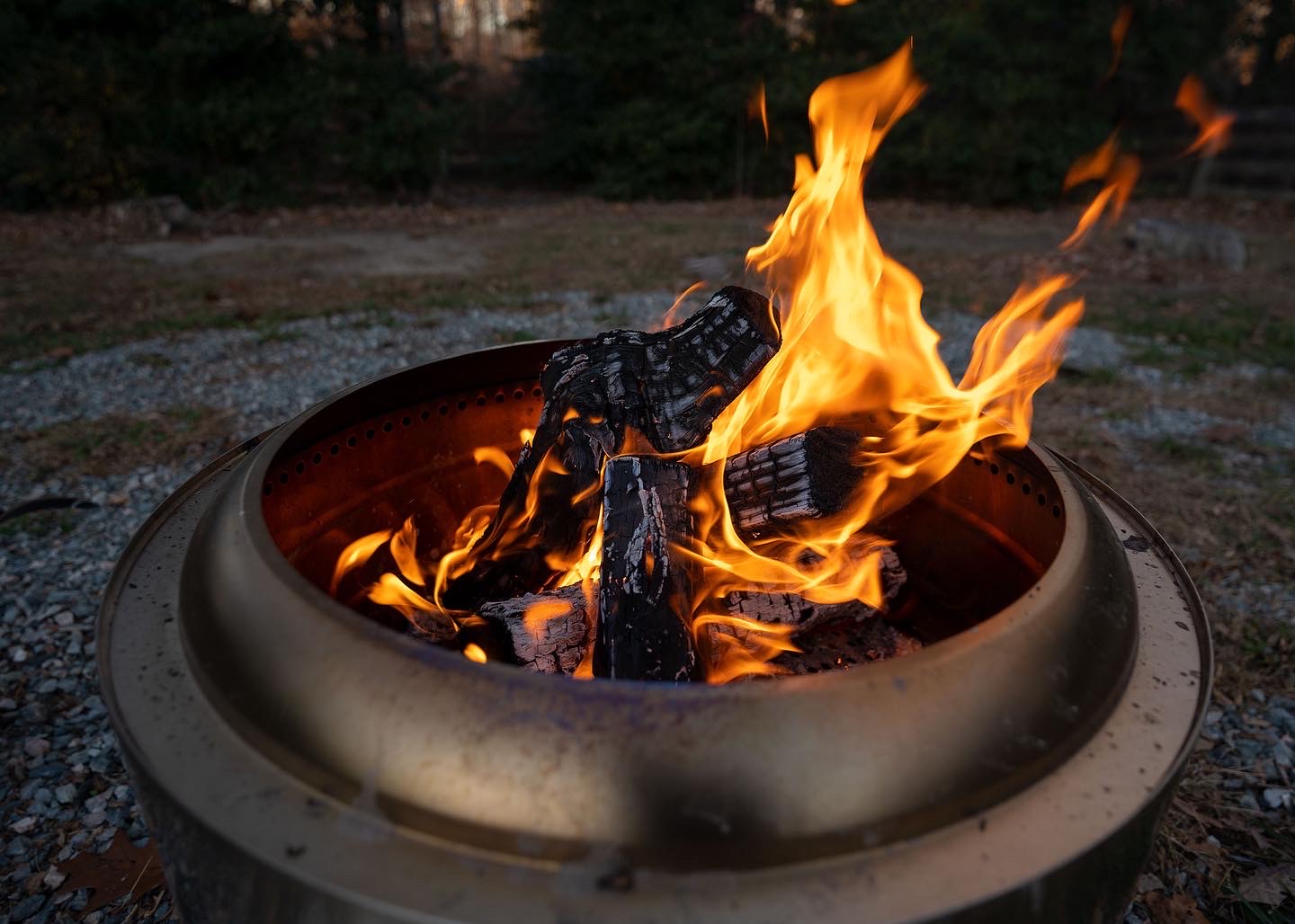
For the waterproofness test, I removed the putty from its waterproof packaging and submerged it for 7 minutes. After its dunk the Pyro Putty was slow to light and didn’t burn as hot as it did completely dry. The good thing is the waterproof packaging would protect the putty from such a long exposure to water. In my high wind test the Pyro Putty stayed lit with a leaf blower simulating a strong wind. So, if you’re trying to get a fire going when the rain is blowing sideways, Pyro Putty is a great choice.
Pyro Putty is an all-around solution to your fire starting needs. It will work well for a survival kit, bug out bag, campfire, and fireplace. The only drawback to the version I tested is that it’s not a natural fire starter, but Pyro Putty has an all-natural formula available.
Best for Survival: FireFlame
Key Features
- Burn Time: 5 minutes
- Waterproof
Pros
- Easy to carry in a pack or survival kit
- Easily lights wet or dry
- Natural materials
Cons
- Breaks apart
The FireFlame is a paraffin wax fire starter that’s completely waterproof. It doesn’t contain any harsh chemicals, which is great for getting a cooking fire started. It’s also lightweight and comes individually wrapped in plastic. In my test, it burned for five minutes with a good size flame for getting a fire going.
In the waterproofness test, when I took it out of water it was completely unfazed. It burned just as hot and for just as long as it did dry. It was also just as easy to light wet or dry. Though it did not perform as well in the high wind test, it performed far better than any of the other fire starters in the waterproofness test. Given that it is so easy to light wet or dry, and is lightweight, I’d recommend it as my pick for a survival kit.
Best for Camping: Superior Trading Co Light a Fire
Key Features
- Burn Time: 14 minutes
- All natural
- Great performance in the wind test
Pros
- Long burn time
- Large flame
Cons
- Not a great option for a backpack
- Not waterproof
In testing, the Light a Fire stood head and shoulders above the rest in the high wind and burn time tests. It burned longer—with a huge flame—than the other fire starters. It also stayed lit in high winds. With all that good comes the drawback: It does not like getting wet. It struggled to light, and wouldn’t stay lit after its dunk in the water.
Its design isn’t suited to being carried in a backpack. But, the Light a Fire is an excellent choice to keep at home, a cabin, or when car camping. With its long burn time and wind resistance, it will get a roaring fire going for you in prime campfire conditions.
Best for the Fireplace: Midwest Hearth
Key Features
- Burn Time: 11 minutes
- Natural
- Flat design is easy to store
Pros
- Easy to light
- Safe to use for cooking fires
Cons
- Not waterproof
The Midwest Hearth fire starter resembles a thick piece of cardboard. But don’t let the pedestrian looks fool you—these small flat squares are excellent fire starters. In the burn time test, it lasted 11 minutes, which is enough time to get all but the most stubborn fires blazing. It’s not waterproof, and like cardboard, became waterlogged after its 7-minute submersion. It also did not fare well in the wind test. But, my favorite feature of the Midwest Hearth is the flat design and mess-free construction, making it ideal for storing in the home. That combined with its all natural materials and long burn time makes it my top choice for a fireplace fire starter.
Best Natural: Eco-Stix Fatwood
Key Features
- Burn Time: 6 minutes
- Natural wood
Pros
- Sustainable
- Acts as kindling and fire starter
Cons
- Takes longer to light than other fire starters
Fatwood is harvested from the heartwood of dead pine trees. It’s naturally high in resins that make it easily catch fire and stay lit even when wet. In the burn time test one piece of Fatwood burned for 6 minutes. When wet, it took longer to light—but once lit, it burned well. I think it’s best to use multiple pieces of Fatwood as your kindling and fire starter in one. The wood catches fire in a few seconds with a regular lighter. If you really want to make the job of starting a fire easy, pair the pieces of Fatwood with one of the other camping fire starters in this list.
Best Ferro Rod: Exotac fireROD
Key Features
- Tinder capsule
- Waterproof
- Machined aluminum body
- 5/16-inch diameter ferro rod
Pros
- Ferro rod is easy to replace
- Easily lights tinder
- Ergonomic handle
Cons
- Price
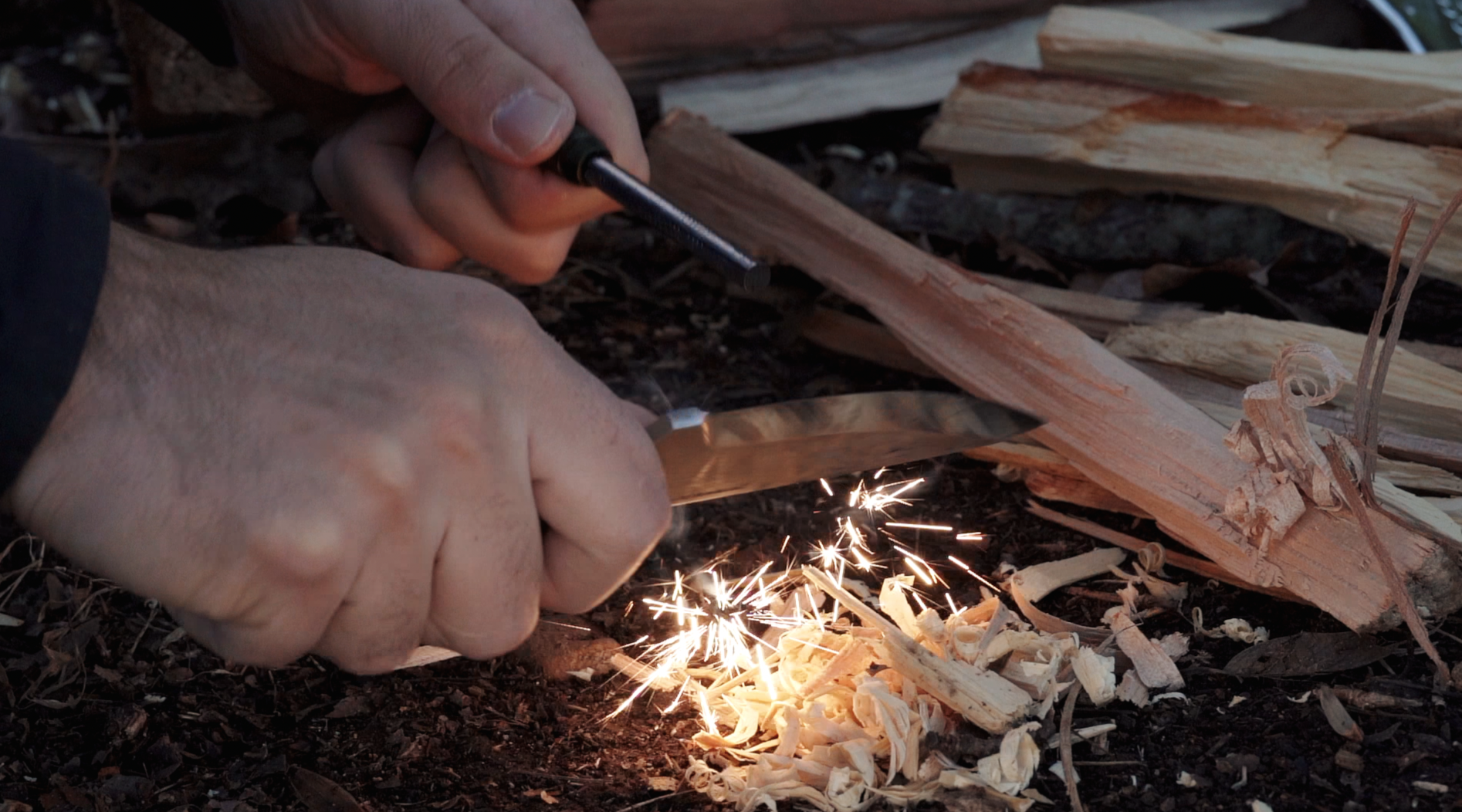
While you can start fires with lighters and matches, a ferrocerium rod is an excellent option for survival and for skill building. They’re a great survival option because they’re waterproof, portable, and with one ferro rod, you can light hundreds of fires. They take time to master, but building the necessary skills to use them is a worthwhile investment for outdoor enthusiasts. There’s no better ferro rod on the market than the Exotac fireRod. The aluminum handle is ergonomic and gives you a firm grasp in all weather conditions.
Whether you use a knife with square spine or a dedicated striker, the 5/16 inch diameter ferro rod throws a hail storm of sparks. It also has cool features like a tinder capsule that holds Exotac quickLIGHT tabs, so you’ll always have fire starting tinder. If you ever wear out the ferro rod you can easily replace it by threading in a replacement. The fireRod’s downside is its price. It is more expensive than other ferrocerium fire starters, but it has features that others don’t and will last indefinitely with replacement ferro rods.
Read Next: Best Ferro Rods
Easy DIY: Dryer lint, egg carton, and candle wax
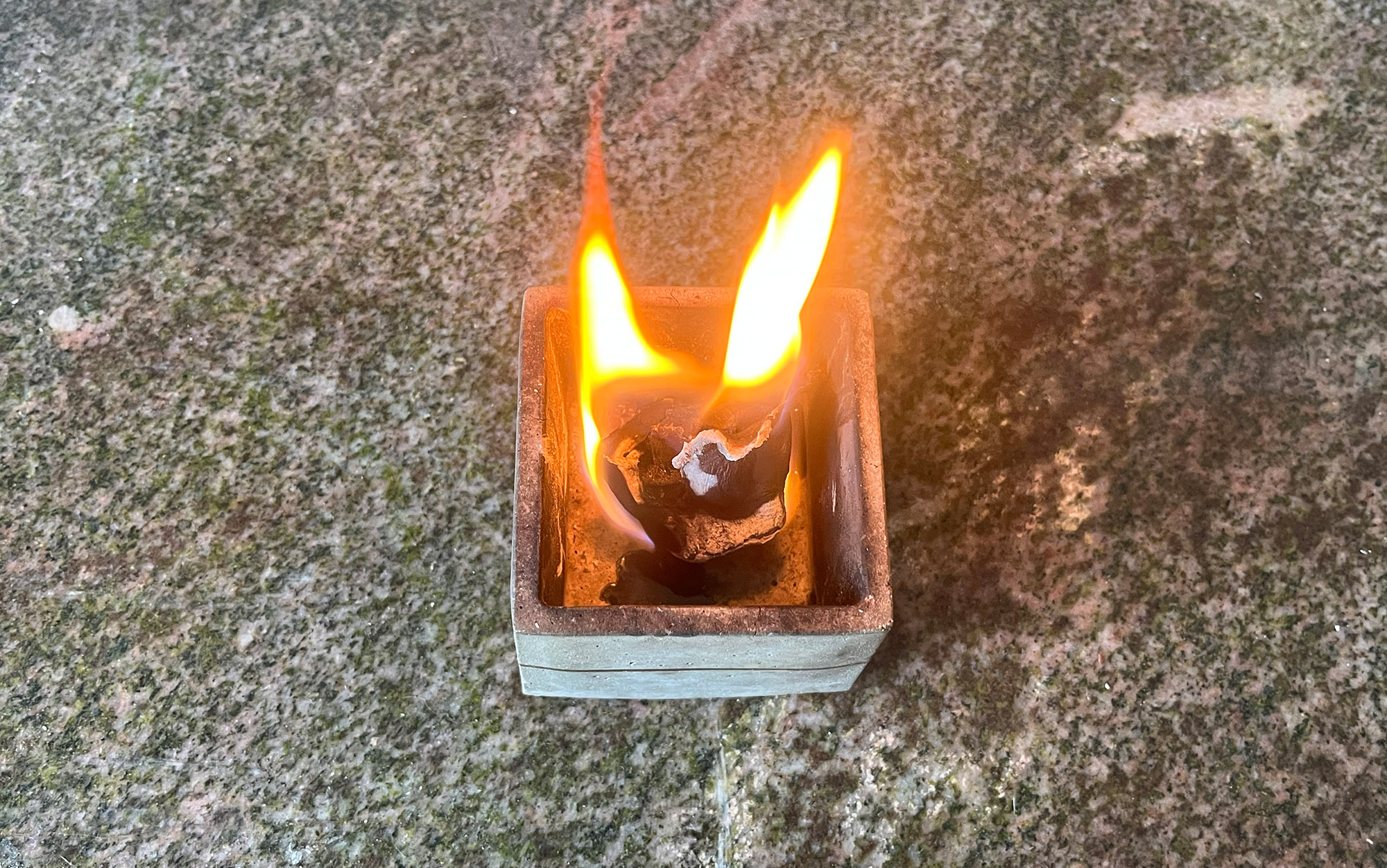
Key Features
- Burn Time: 9 minutes
Pros
- Free
- Reusing waste
- Lightweight
Cons
- Not waterproof or windproof
While having a sure-fire way to start a fire in am emergency is a good idea, this easy DIY version is free, lightweight, and you probably already have everything you need. It takes a minute to light (I usually light it in multiple places), but it burns for a while. Your kindling has plenty of time to catch. Making these DIY fire starters is quick and easy. Just pour the last of a candle over an egg carton stuffed with dryer lint. Cut them apart into twelve easy-grab fire starters.
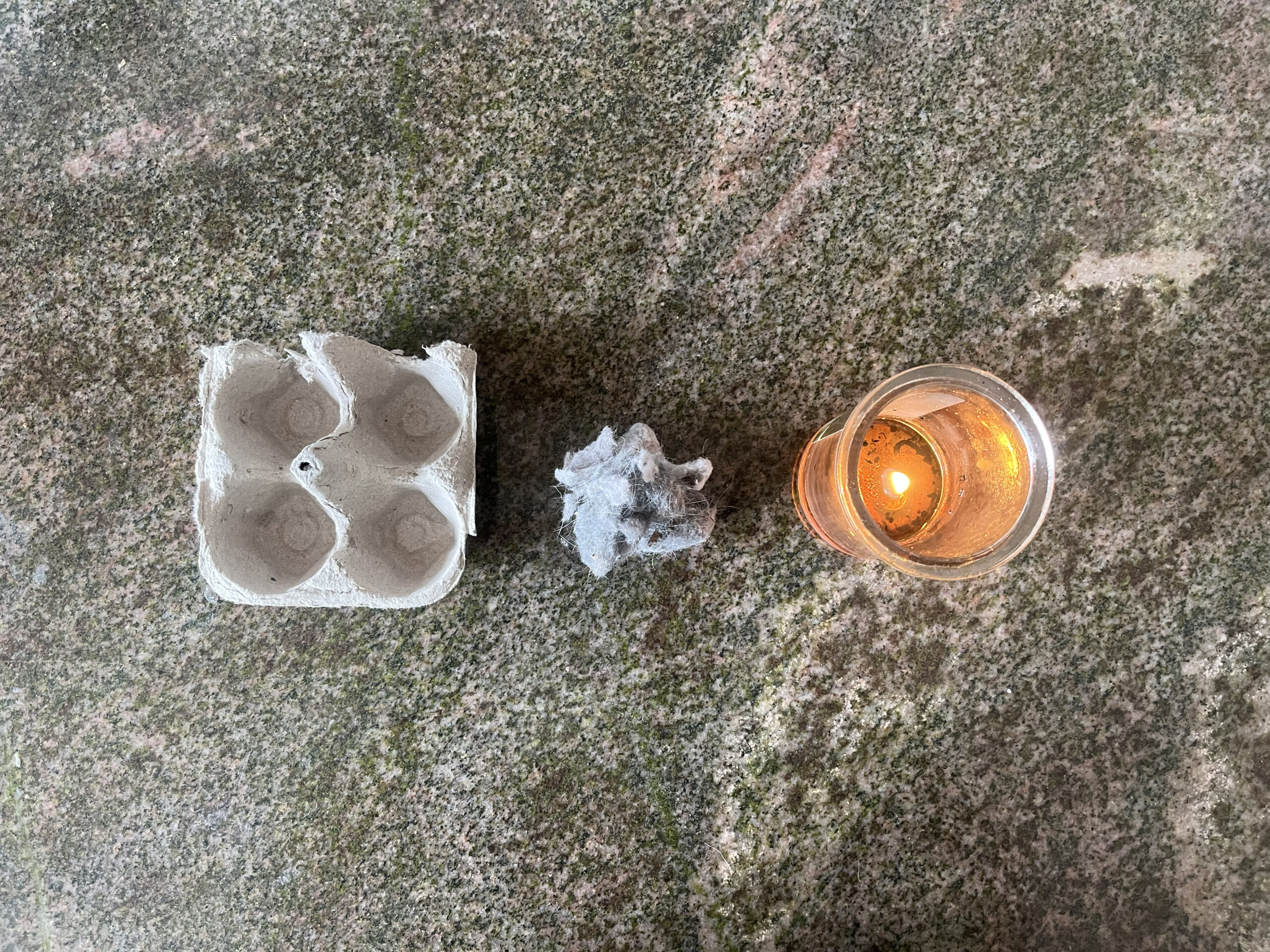
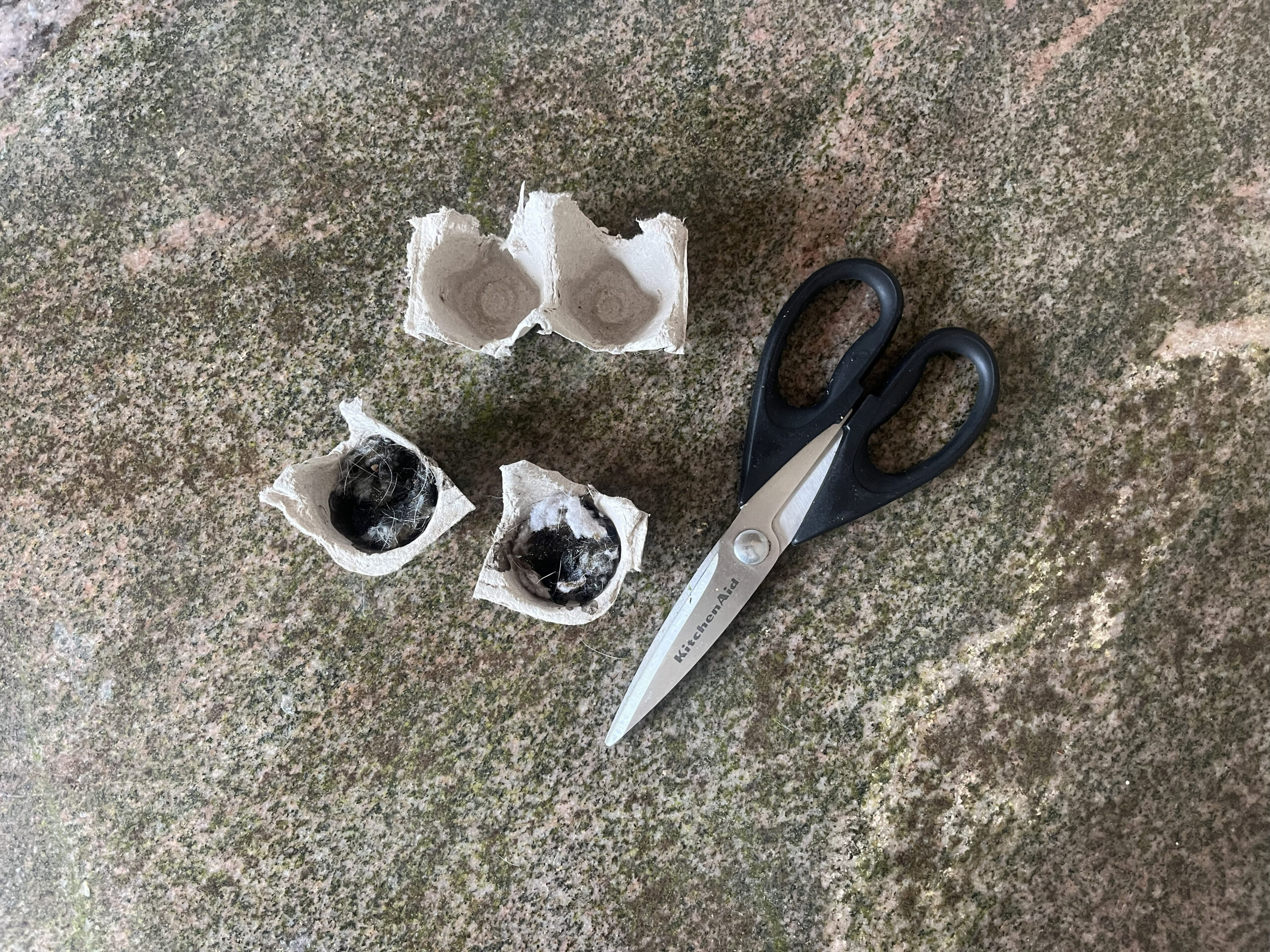
The DIY fire starters refused to light when wet and didn’t handle high wind very well, but they burned for a good 9 minutes. If you’re headed camping or starting a backyard bonfire, these are a great way to re-use things you’d otherwise throw away and quickly start a roaring fire. I like to use the lid of the egg carton as extra paper to really get a flame going.
How to Choose a Fire Starter
All of these fire starters are fantastic, but the key is choosing the best fire starter for you. Do you need a packable and weatherproof fire starter? Then the Pyro Putty or Fire Flame would be your best choices. If you want a fire starter for your home, cabin, or car camping your choices are more broad. It’s also a good idea to consider the ignition source for your fire starter. Will you be lighting it with a lighter, matches, or ferro rod? Even the best ferro rods, won’t light certain fire starters like the Midwest Hearth, but they’ll easily ignite Pyro Putty.
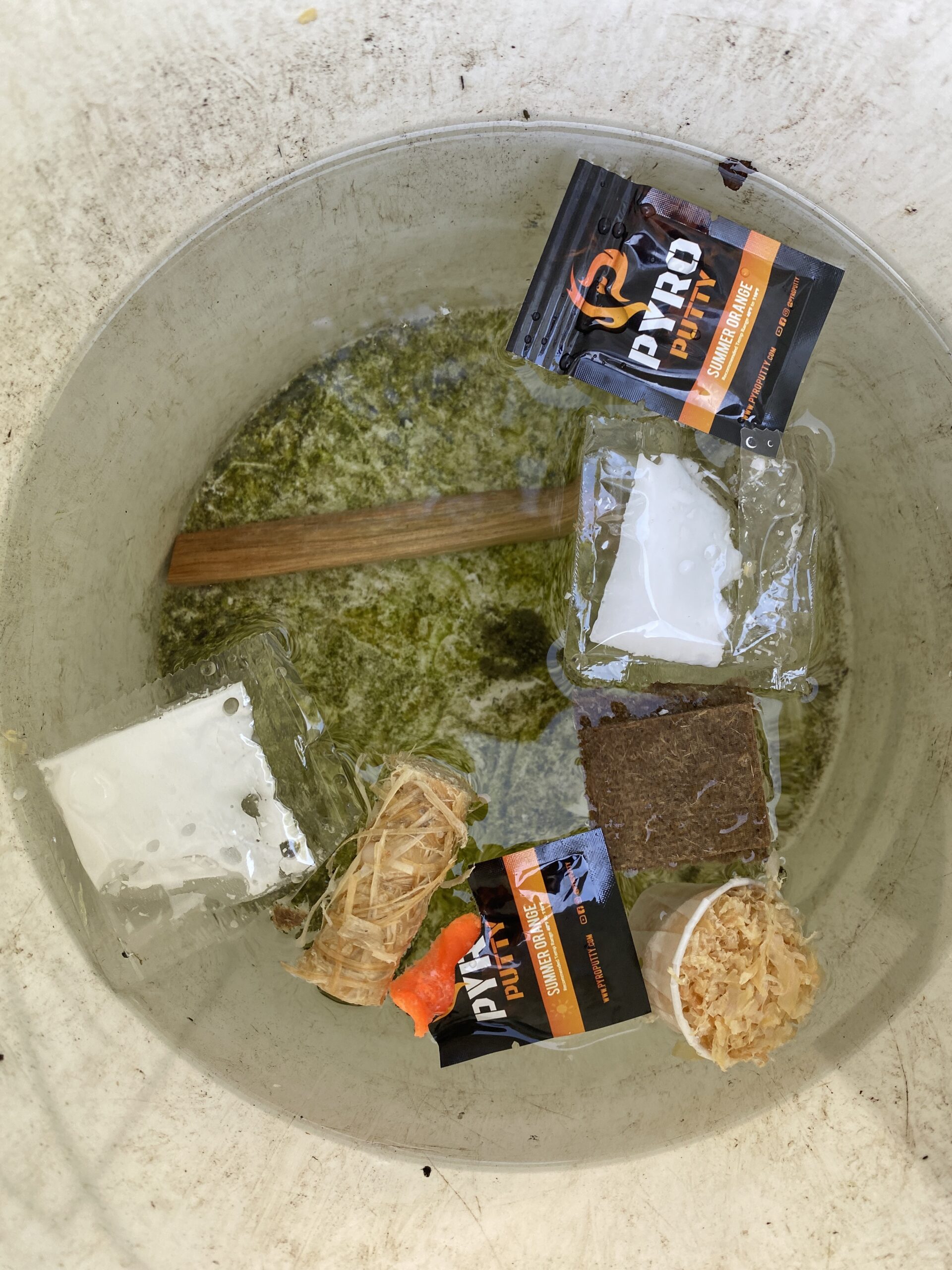
Fire Starting Tips from Kevin Estela: Types of Fire Layouts
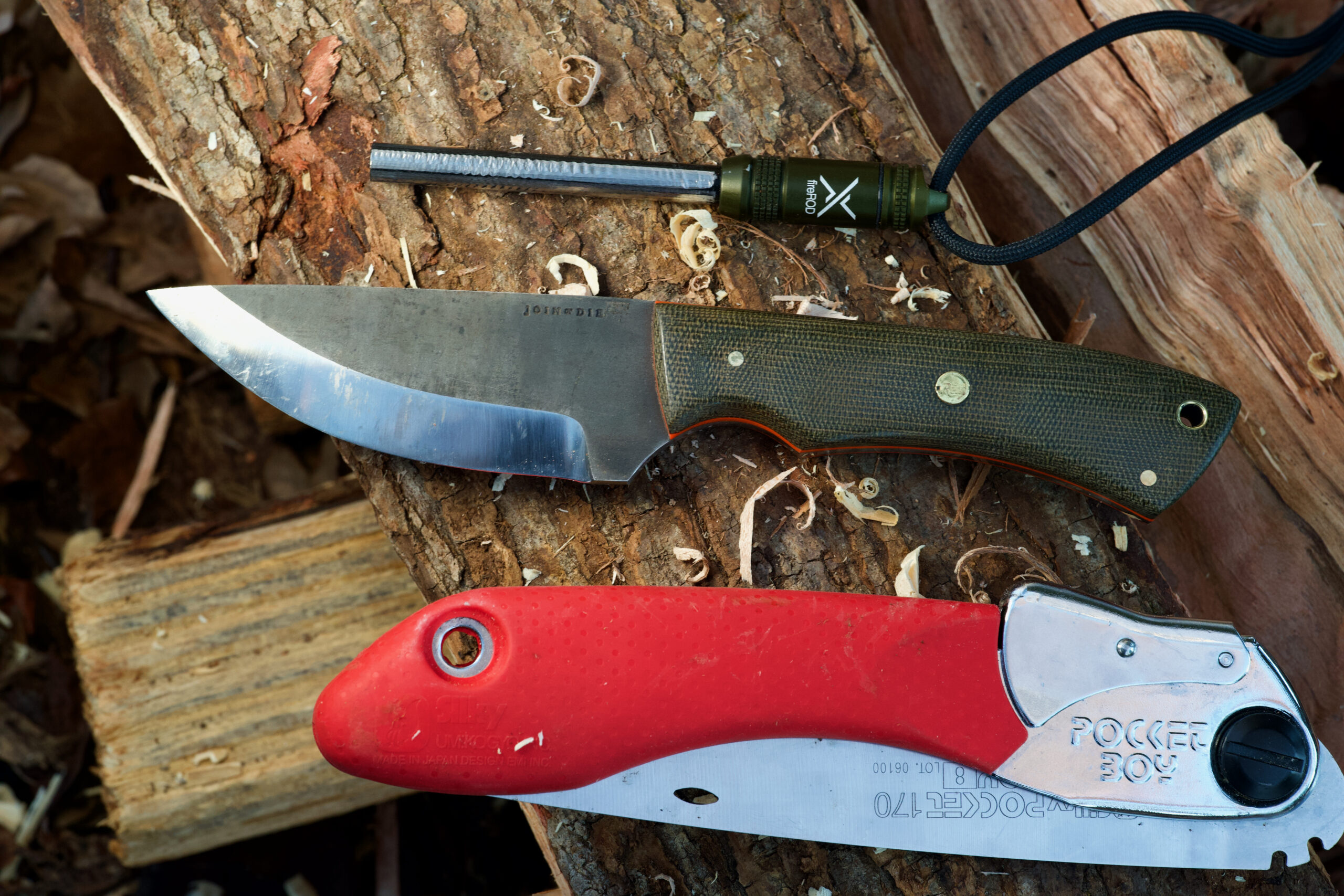
Assuming you’ve identified the location where you want to build a fire, you must think about what type of fire will help you accomplish your goal. There are different ways to arrange your fire that will produce maximum light and heat, burn for a long time, and other ways that allow you to control the amount of heat you use to cook with. How you assemble your fire is referred to as a “fire lay.” Here are the common fire lays and what each is best for.
The Tipi
Perhaps the most iconic and easily recognizable fire lay is the tipi fire that draws its name from the cone shaped configuration of firewood. This fire lay burns quickly, much like a wooden match held upside down, and it produces a tall bright flame. It is a good fire lay if you need to warm someone or if you want to illuminate your campsite at night.
Log Cabin
An alternative to the tipi is the log cabin fire lay. Much like Lincoln Logs, this fire lay is built up with perpendicular logs creating a box and it can be used for cooking as it burns very steady and doesn’t flare up.
Platform and Brace
A hybrid of the log cabin fire lay is another called the “platform and brace”. Think of this firelay like a single corner of a log cabin built up on a heavier log that allows for airflow. The corner of the platform and brace points in the direction the wind is blowing and the initial fire is lit to the inside of the corner. This forces the flame into the material you wish to burn.
Long Fires
Additional fire lays include long fires that are built the entire length of a body, resting alongside it. The long fire is popular among winter camping enthusiasts and bushcrafters that use it when temperatures drop and wood resources are plentiful.
Star FireSimilar to the long fire, the star fire is used by groups of outdoorsmen camping next to a fire for the night. The star fire has a central fire with long logs extending out from the center like spokes on a wheel. The campers sleep between the spokes and throughout the night each camper can push the nearby spoke into the fire to keep it burning.
For Estela’s full article on how to build a fire, click here.
Read Next: How to Start a Fire
FAQs
The most pressing questions—and answers—for buying your next fire starter(s).
The best fire starter for a fire pit is the Superior Trading Co Light a Fire. It burns for 14 minutes with a large flame to easily get a fire going and it’s also excellent in high wind.
You absolutely do not need to buy a fire starter, but you do need a tinder of some kind, whether that’s a feather stick, birch bark, or harvested fatwood.
Some fire starters can expire, and others can absorb moisture if not stored properly. Refer to the manufacturer’s info on expiration dates and proper storage.
Final Thoughts on the Best Fire Starters
Each of these tested and vetted fire starters will help you get a roaring fire going so you can spend less time building a fire and more time enjoying it. The key is to choose the best fire starter for your application, use fire starting fundamentals, and always put safety first when building fires.
- Best Fire Starter: Pyro Putty
- Best for Survival: FireFlame
- Best for Camping: Superior Trading Co Light a Fire
- Best for the Fireplace: Midwest Hearth
- Best Natural Fire Starter: Eco-Stix Fatwood
- Best Ferro Rod: Exotac fireROD
